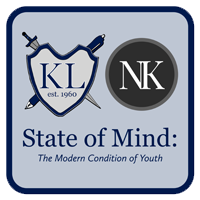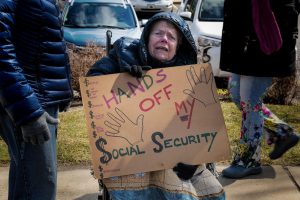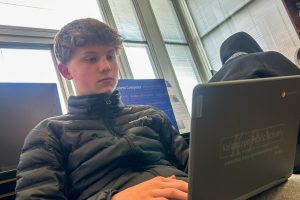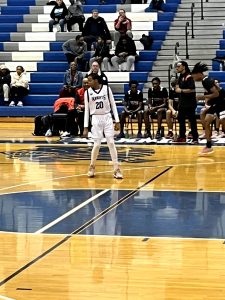More than just anger: teen radicalization on the rise
Credit: Elias Nagel-Bennett
Pictured (left to right): Reaghan Babrick and Canaan Hogan talking about affordable policy in Kalamazoo. The issue of lessening rising home prices and rent has become a key issue not only in Kalamazoo but across the nation, and various solutions have become parts of the major parties platforms.
March 15, 2022
 Editor’s note: This story is part of “State of Mind: The Modern Condition of Youth,” produced in partnership with local, independent news outlet NowKalamazoo, which provided editorial support and guidance.
Editor’s note: This story is part of “State of Mind: The Modern Condition of Youth,” produced in partnership with local, independent news outlet NowKalamazoo, which provided editorial support and guidance.
Banners and signs held high, a group of impassioned youth march in the streets chanting the latest slogans, the noise of their leader on a bullhorn pouring over the surroundings. This scene is the same every year in dozens of cities throughout the country.
Protest has always been a key part of democracy, but for those that are younger, especially those under 18, public protest and petition are the only ways to directly pressure policy makers and get politically involved.
Senior Faye Thompson, who has attended BLM and Nurses Union protests along with the recent walk out said, “I often find that being a student at the nurses union protest gets me brushed over a lot. When it’s student-led, I get more respect, as I am a student, and it shows young people standing in solidarity.”
Since the 1960’s, teenagers and young adults have gotten more and more engaged in politics, partially due to the emergence of the internet. According to the study “The effect of the internet on voting behavior” by Stephan Heblich on the IZA World of Labor can lead to greater voter interest in certain demographics, notably those who actively engage with online discourse, leading to the highest youth turnout of all time in the 2008 presidential election. More and more, people are choosing to vote as soon as they can.
According to the infographic “Voter turnout among 18-24 year olds in U.S. presidential elections 1964-2020” published on Statista by Aaron O’Neill, voting rates among 18 to 24 year olds have risen 10% in the time between 2012 and 2020, coinciding with the growth of social media.
While civic participation is considered to be beneficial for a democracy, according to the online publisher “Frontiers” section on “Radicalization Among Adolescents”, “The phenomenon of radicalization among adolescents has become a global issue given the increasing number of youth becoming involved in extremist groups and acts.” With such a large issue, there is cause for significant worry as to the development of politically polarized and particularly radical high school students, who go beyond the norms of political activism and seek instead a violent and complete transformation of society.
In the study “What Does the Political Divide Mean for U.S. Teens?” conducted by Benjamin Oosterhoff, Ph.D. and published in Psychology Today, it was found that people between 13 and 18 felt more than double the stress stemming from U.S. politics than those above 18 and have damaged significantly more relationships over political differences. Youth activism and interest in politics has risen hand-in-hand with stress and anxiety for the very same youth – but why?
One explanation is that many minors rely on government spending even more than adults, due to a hash lack of job prospects or independent income. In welfare spending and education, minors are major beneficiaries of federal and local spending but have no vote in these matters. Children, with little direct income of their own, are some of the most vulnerable to changes in government policy. Things like free or reduced lunch, tax deductions, food stamps, and Child Protective Services all provide children, especially for those under the poverty line, with essential aid. This means a pullback or repeal of one of these programs, or the myriad others that benefit minors, could harm many under 18.
It can come as no shock that the younger generation is more partisan than older ones. According to a study from Stanford and Brown University, it can be shown that the average partisanship of those with internet access is 30% above the average for those without internet access. A key feature of youth activism is the use of the internet, whether to spread ideas or information, a key part of the January 17th student protest at Loy Norrix.
“With the recent walk out, students spread the word mainly over the internet. Social media is the fastest way to get the most people in the loop,” said Thompson.
The Stanford and Brown study reveals a greater rate of political extremism in those with frequent internet access and use of social media, and it’s those between 18 and 39 who have the highest rate of social media use, which means the internet is at least partially leading into their more radical views. This trend for higher use of the internet also applies to those under 18, as they consume as much if not more online content than those over 18.
Social media has also been identified as a threat to youth mental health in “Protecting Youth Mental Health” an advisory from the surgeon general, due to a general lack of safety standards in the industry.
Sue Ellen Christian, a Professor of Communication at Western Michigan University, has studied the effects of social media and online indoctrination on political discourse extensively.
Professor Christian said, “For most teenagers, their ability to access information digitally is nigh unrestricted.”
Many websites are noted for their effect on those who frequent them—among them, Twitter, 4chan, Facebook, and Youtube are prominent for their political content. Though most of these sites have taken recent steps to change, they all still give a platform for propaganda and a place for those who have already become extremists to surround themselves with like-minded thinkers.
“It’s very easy to choose the information we feed ourselves, and if we only seek news from a single point of view, we get a warped version of reality,” Professor Christian said.
Social media and self interest are not the only reasons for getting involved in politics. Many get involved in order to try to create change, such as the members of the Young Democrats club here at Loy Norrix. The club, though not officially affiliated with the Democratic Party, has sought to make waves locally with goals centered around addressing housing and issues related to healthcare.
Junior Guthrie Harris, one of the leaders of the club said, “The club’s about engaging students in political participation, learning about the political atmosphere and how to approach issues in an effective way.”
Government and Politics teacher Kyle Shack, advisor to the club, helped to re-establish the Young Democrats. He takes a backseat role in the club’s activities and discussions but gives his full support to student involvement in politics.
“I think it’s [student activism] incredibly important and widely undervalued,” Shack said.
But even in a club that emphasizes mental and physical health, stress and polarization are prevalent.
Junior Clara Moss, another leader in the club, said, “I’d say during the 2016 and 2020 elections, the tide of politics in the country was stressing me out.”
But stress isn´t the only symptom of student involvement in politics. Often, ideological radicalization can be driven by factors unique to minors, whether that is high social media use or the influence of their friends and family.
¨I mean, my political outlook has been pretty steadily radically left since I can remember. Shaped by my peer groups, family,” said Harris.
But the Young Democrats and the left wing of American politics in general are not the only groups which involve minors in their movement. While the Young Conservative club at LN was not able to be reached for comment, it is clear that both sides of the political aisle are more radicalized than they have been previously.
According to the National Education Association, more and more youth are turned to the radical right, often due to issues in their personal lives, causing them to see highly politicized groups as their social circle.
Professor Christian said, “There is research that shows that people who feel socially isolated can get a sense of belonging from a conspiracy group, an extremist group.”
The same website can show us part of what these harmful levels of political involvement look like. They’re defined by stress and anger over the political situation that go beyond personal stakes. When someone, especially a minor, whose mind isn’t fully developed, shapes their entire view on the world around politics, whether left or right, it can cause alienation of friends, physical changes, and permanent radicalization.
Furthermore, according to the report “Effects of Stress on the Developing Brain” from Bruce S. McEwan published by US National Library of Medicine, excess stress from any source, including politics, can permanently change minors “brain architecture, increase anxiety, alter mood, and decrease memory and cognitive flexibility.”
In short, political stress and radical ideas can permanently alter teens’ social lives, brain structures, and world view.
But in some cases, radicalization and anger is not the end point, but the final step before something even darker—terrorism. The traditional picture of a terrorist is a grizzled, middle-aged man with a big organization backing them up. However, according to the article “Teen terrorism inspired by social media is on the rise. Here’s what we need to do,” written by Farah Pandith and published by the National Broadcasting Company, the fastest growing and widening demographic for both individual and group-based terrorists is teens.
While cases such as recreuitment to the Islamic State being primarily among Muslim teens is well-documented, fascist and Neo-Nazi movements commonly find their prey among the younger generation with indoctornation into these violent online communities occuring as early as 13 or 14 in some cases. These teens are quite often arrested in relation to or even masterminding plots to carry out shootings, bombings, kidnappings, or other acts of violence. Many mass shooters in the United States are motivated at least in part by extremist ideas.
In the age of unlimited online information and a fiery political climate, the line between healthy participation in politics and physically or mentally harmful obsession is not clear. In the past, youth-centric politics have had a variety of outcomes, from the genocidal policies of the Cambodian-based Khmer Rouge during the 1960’s and 70’s, who used teenagers as their primary base, to the great triumphs of the SNCC (Student Nonviolent Coordinating Committee) during the Civil Rights movement in America.
Radicalization in the United States, especially among younger generations, is at its worst point ever recorded, and politics have also become more polarized in the last century. With so many indicators, a clear distinction between healthy activism and harmful obsession is clearly needed not only in schools but vitally, online.












